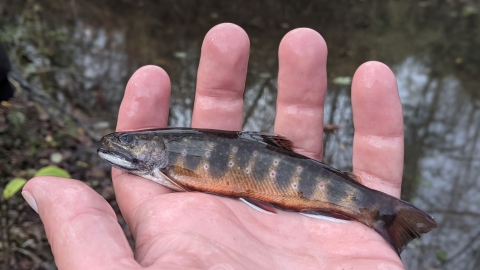Seasons of Wildlife
Whittlesey Creek National Wildlife Refuge offers wildlife viewing opportunities year round. We encourage you to explore your refuge lands during different seasons for a chance to see and hear a wide range of wildlife.
Spring and Fall
Migration during the spring and fall months may be the most exciting time to visit the refuge. Shorebirds, ducks, warblers, herons, bitterns, rails, swans, hawks, eagles and falcons are in abundance and active throughout the refuge.
The annual Chequamegon Bay Birding and Nature Festival takes place each year in May during peak migration. This event offers more than 100 different field trips and programs on all things nature from birds to geology. It serves as an excellent opportunity to learn more about natural resources and engage with local experts.
Summer
Summer months are an excellent time to scope out shorebirds such as plovers, sandpipers and yellowlegs. Flycatchers and warblers use the refuge habitat throughout the summer. Grasslands are typically abuzz with insects which feed many types of birds.
Winter
Many animals stay active on the refuge in winter months. It is common to see waterfowl such as mallard, bufflehead and common goldeneye using the open waterways. Bald eagles may be spotted perched in trees along the shoreline or flying overhead. Finches, waxwings, woodpeckers and owls can be frequently seen and heard. Evidence of wildlife presence may be seen by tracks in the snow. Some animal tracks you may see in the snow on the refuge include otter, fox, mice and birds.
Featured Species
You might catch a glimpse of coaster brook trout and migratory birds when you visit the refuge. These species depend on the streams and forests found throughout the refuge for spawning and nesting, as well as brood rearing habitat. You might also see game and non-game animals like white-tailed deer and porcupine, as well as large and small mammals like beaver, muskrat and a variety of insects and herptiles.
Coaster brook trout are a migratory fish that spawn in Whittlesey Creek and spends their adult life in Lake Superior. Coaster brook trout populations declined significantly around the early 1900s and efforts are currently under way to re-establish their populations in Whittlesey Creek. Whittlesey Creek is a cold-water, groundwater-fed stream, classified as a Class I trout stream by the Wisconsin Department of Natural Resources. Groundwater discharge keeps the stream at a relatively stable temperature all year, which is critical for over wintering coaster brook trout eggs and young.
The black duck is a migratory bird that favors wooded swamps and marshes for breeding. Although not very common, you can see them wintering along Whittlesey Creek and breeding in local estuaries.
You will need keen eyesight to catch the sight of an American bittern. This wader can be seen in shallow marshes, but can disappear quickly, especially when striking a concealment pose with neck stretched and bill pointed skyward. These stealthy birds stand motionless amid tall marsh vegetation, and patiently stalk fish, frogs and insects. American bitterns host a distinctive low-pitched call that sounds like the gulps of a thirsty giant.
The northern parula warbler is a small bird found in the upper forest canopy, but more often heard than seen. The females create a hanging nest, usually built from moss and lined with fine grasses or pine needles. Refuge lands are important habitat for migrating warblers and other neotropical migrants.

